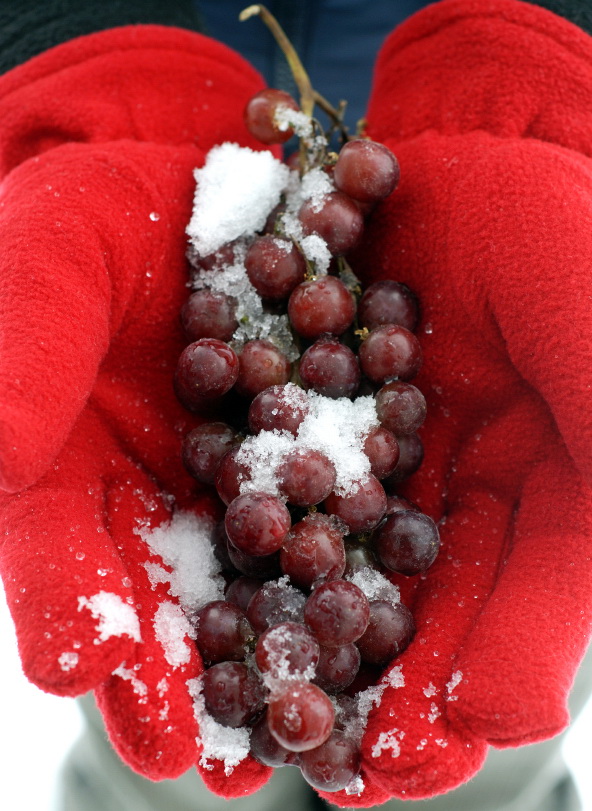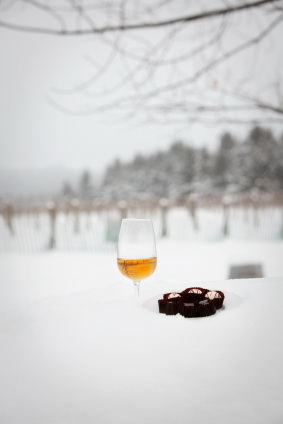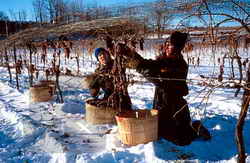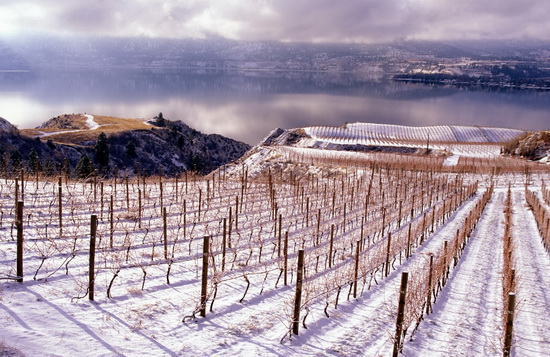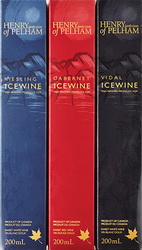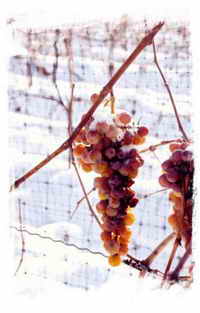On Global Television yesterday, we discussed the Canadian Icewine harvest.
Here’s a sneak peak at some of the wines that we’ll be featuring, along with reports from the field.
Fun Facts: The Upside of the Deep Freeze
Our deep freeze recently turned out to be bonus for Ontario icewine winemakers. The sustained cold snap and arctic temperatures allowed them to harvest grapes in an unusually short time.
Who makes the most Icewine?
Ontario produces about 80% of Canadian icewine, with the remainder mostly in British Columbia though some is also made in both Quebec and Nova Scotia. About 60 Ontario wineries produce Icewine.
How big is the Icewine harvest?
Only about 7% of grapes grown in Ontario vineyards go to Icewine production, or approximately 3600 tonnes this year that will make about 540,000 and 576,000 litres of Icewine.
How many grapes in a bottle of Icewine?
It requires 8 pounds of frozen grapes to make one small half bottle of Icewine (375 ml). Eight pounds of unfrozen grapes can make 6 full sized (750 ml) bottles of dry wines.
Who buys the most Icewine?
In 2013, Chinese about about 42% of Canadian Icewine, worth $8 million. Other Asian countries, including South Korea, Japan, Taiwan and Singapore, bought another 30%.
2014 Canadian Icewine Harvest
Live Reports from the Field
Anne Sperling, Southbrook
2010 Southbrook Vidal Icewine
2013 Southbrook Cabernet Franc Icewine
What’s different about your Icewine?
Both of these wines are estate grown, and are both organic and biodymanically farmed, with the Demeter Biodynamic Certification.
Southbrook Vineyards Vidal Icewine
Niagara Peninsula, Ontario, V.Q.A., Canada
When did you pick the grapes?
November 18, which was the earliest opportunity to make Icewine in Niagara, which was a record. We chose to wait for the grapes to go through some freeze / thaw cycles which reduces yield but increases complexity.
Extreme cold weather from last winter reduced bud viability and total crop to 40% of normal.
What about those pesky birds?
We experienced the highest bird pressure ever, and high winds damaged the nets protecting the vines which allowed birds better access to the grapes.
This year, the birds were innovative – it was the first time we saw them hanging upside down from the vines, to access the berries that gather in the bottom of the nets.
Including losses to bird pressure, total harvest is down to 25% of typical.
Any other hungry predators who enjoy a grape snack?
While we are used to dealing with birds, and net the vines to offer some protection, this year one whole row closest to the woods was lost to racoons.
Hard to know why they are more active. In addition to eating the grapes, they also rip apart the nets creating a need to replace them.
Editor’s Note: Perhaps a racoon-ragout and icewine pairing is in order ;)
Southbrook Vineyards Connect White Vidal
Niagara Peninsula VQA, Ontario, Canada
What about the recent cold snap?
This current cold snap has allowed for ideal harvest conditions, with sufficient time to press the grapes while they remain at below -8 degree temperatures as required by VQA regulations.
What changes did you make with Icewine this year?
Due to the reduced crop of 2014, all of our estate-grown grapes were harvested for dry table wine. We are now working with one of our long-time organic growers to supply the ice wine juice this year.
What trends are you seeing for Icewine?
We are seeing a renewed interest among sommeliers for including Icewine 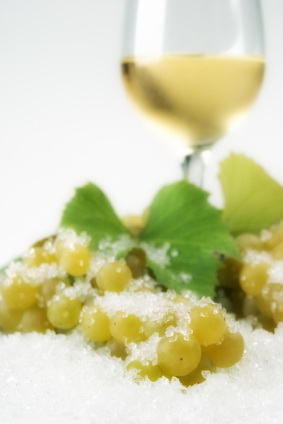 on their tasting menus and other food and wine pairing opportunities. We are happy to see this trend, as we ensure that our Icewines possess the acidity required to balance their natural sweetness.
on their tasting menus and other food and wine pairing opportunities. We are happy to see this trend, as we ensure that our Icewines possess the acidity required to balance their natural sweetness.
What’s your most unusual food pairing for Icewine?
This holiday season, I served Christmas Pudding with an Icewine reduction and smear of paté de foie gras.
Creme caramel is also a favourite Icewine food pairing. We also enjoy the traditional pairings like hard and blue cheeses, and desserts made with tree fruits.
David Paterson, Winemaker, Tantalus Vineyards
How was 2014 different from other years?
This year was incredibly early. Which meant we were using frozen grapes that could have been picked as table wine. There was no desiccation just clean pristine sweet juice.
What surprised you most?
The clarity of the juice surprised me. it came out of the press with the clarity of juice that had been settled in tank for a few days.
Any interesting stories from this year’s harvest?
It was a boringly uneventful harvest with everything going as planned.
What changes did you make with Icewine this year?
I changed my yeast to a yeast that has been specially developed from a strain of yeast found in the Sauternes region in Bordeaux, France.
What trends are you seeing for Icewine?
It seems to me people are embracing more and more acid in the wines which helps balance the wines and keeps them from being flabby and syrupy.
What’s your most favourite food pairing for icewine?
Our Syrah icewine with juniper cured smoked venison loin on crustini with blue cheese and pickled red onion.
Henry of Pelham
Henry Of Pelham Cabernet Icewine
Henry of Pelham Estate Winery Vidal Icewine
Henry of Pelham Estate Winery Niagara Escarpment Riesling Icewine
Henry of Pelham will harvest approximately 150 tonnes of Riesling, Cabernet Franc and Vidal grapes of Icewine for the 2014 harvest.
Henry of Pelham Winery Icewine Trio
Ontario, Canada
How was it different from other years?
The 2014 vintage was a smaller crop than the average for some varietals, but not the core of our Icewine production which is Riesling.
In the Short Hills Bench we often see the necessary cold weather (-11 C) anywhere from late November to early January, typically earlier than most other Icewine producing appellations.
Like other milder years (the late 1990s) the winter cold was slow to come this season but the grapes hung well and we have brought the fruit into the winery on January 5, 2015.
Biggest challenge this year?
Really we were just waiting on the cold weather, but the quality is amazing because of the long cool ripening period from September to October. The fruit looks really good.
Anything different about this year’s harvest?
Unlike most years where we comb the vines with our miners’ hats on at night, this year was one of the rare ones where we harvested during the day.
What changes did you make with Icewine this year?
The biggest change overall for us is that all of our fruit moves by gravity, including Icewine. While the gentle handling is less of a concern for Icewine, this new process allows for a quicker and more efficient movement of the grapes which ultimately preserves the freshness of the wines, a mark of our house style.
What trends are you seeing for icewine?
Icewine is slowly being seen as a wine that isn’t purely seasonal, for example at just Easter or Christmas. The big push is to get wine drinkers to think of it as a wine to start the meal, not just finish it with. We are also promoting its use in fine cocktails.
What’s your favourite food pairing for icewine?
My favourite time to drink Icewine is at the start of a meal when we’re all just hanging around, eating things like flavourful cheeses, cured meats like prosciutto, chorizo etc.
Salty foods and sweet wines like Icewine are a great match. The most unusual, but also fantastic match: Icewine with a spicy Indian curry dish. In this case, I drink the Icewine the way I would other still wines — a proper wine-glass pour (not a small 2 oz tasting). Try it — you’ll be surprised.
Angelo, Cave Spring
2013 Cave Spring Riesling Icewine
2012 Cave Spring Riesling Indian Summer
How was the 2014 vintage for Icewine?
This was one of the best in the 25+ years for Cave Spring Icewine because the 2014 growing season was on the cool side and the regular Riesling harvest finished end of October so that the grapes were in excellent condition to hang into early winter.
In a warmer year and with an earlier regular harvest, the grapes tend to be over-ripe for late season hanging on the vine and there is a possibility that there will be some breakdown and rot which needs to be culled.
Cave Spring Cellars Riesling Icewine
Niagara Peninsula, Ontario V.Q.A., Canada
This year there was absolutely no breakdown and the Riesling was in pristine condition. What was surprising is how well the grapes held up on the vines into the first week of January.
Weather cooperating, we like to harvest in December, before there is too much desiccation, which sometimes happens when the grapes have to hang into January, but not this year.
Daytime or night picking this year?
Another plus is that we were able to pick for three days in a row during daylight hours which makes it much easier than during dead of night, so that we were able to pick and process more efficiently. Rarely do we get an extended cold spell where we can do this.
Cave Spring Cellars Indian Summer Select Late Harvest Riesling
Favourite Icewine food pairing?
Serve Icewine as an appetizer with some blue cheese on a toasted panettone. Also, a foie gras terrine generally goes very well with ice wine too especially if paired with some dried fruit or served on a brioche.
More to follow soon from …
Reif Estate Winery Vidal Icewine
Niagara River, Ontario VQA, Canada
Klaus Reif, Reif Estates
2013 Vidal Icewine 200ml
2009 Riesling Icewine 200ml
Reif Estate Winery Vidal Icewine
Niagara River, Ontario VQA, Canada
Canadian Icewine 2014: Heroic Harvest = Epic Wine
Anthony: Ice wine is a favourite dessert wine for so many in Ontario and around the world. Now, the process to harvest and produce it, I find fascinating. What’s even more fascinating is the fact that the vast majority of ice wine comes from this province. Joining me, now, to talk about this, is wine expert Natalie MacLean. Thank you so much for coming back.
Natalie: My pleasure Anthony, good to be here.
Anthony: So ice wine … This is the time of the year, right?
Natalie: It is, it’s very seasonal.
Anthony: Describe the process because it is…
Natalie: Sure.
Anthony: … fascinating. It’s also meticulous and very difficult.
Natalie: It’s very difficult and only 7% of our total harvest in Ontario is dedicated to ice wine. If we make a comparison, it takes 8 lbs. of grapes to make one of these little half bottles of ice wine. That same amount, 8 lbs. of grapes would make 6 bottles of regular wine.
Anthony: So what happens if you have a bad harvest? Has that happened?
Natalie: Yes it does, sometimes some of the winemakers are not making ice wine. This year though was a great harvest and there are a couple of reasons why. First of all winter came slowly. I’m sure we don’t remember that given the cold snap we have now. It came slowly and that gave the grapes a chance to thaw and freeze and thaw and freeze. What that does is concentrate the juice and create more complex aromas and flavours in the grapes.
Anthony: So they pick them when they’re frozen?
Natalie: Exactly. What happened this year because we have the cold snap is that unlike other years they were able to pick in the daytime. Most of the time they’re out there looking for those -8 or colder degree temperatures. At night they’re wearing their miners’ hats with a little light on …
Anthony: Yes.
Natalie: … combing through the vines looking for those ice pellets. That’s literally what those grapes are. But this year with the frozen Arctic temperatures that we’ve had, they were able to harvest in the daytime get it all in and they’re saying that the juice is pristine, very clear, very beautiful.
Anthony: Great ice wine coming from Canada but particularly Ontario.
Natalie: Exactly, 80% is produced right here. We also have BC, Nova Scotia and Quebec with smaller amounts. One of my favourite wineries is a Southbrook and it’s a very special producer here in this province. It’s both organic and biodynamic and the winemaker Ann Sperling, is a real leader in the industry. I was talking to her about how the harvest was going. She’s very pleased but she said this year that one of the predators, one of the reasons why there’s such a low grape harvest for ice wine, is birds. Little pesky starling’s love to eat them . This year she said they got really innovative. It’s the first time they saw them hanging upside down from the vines so they could get the grapes under the nets.
Anthony: Come on.
Natalie: Yes, exactly.
Anthony: What are some of the other wines that you want to showcase?
Natalie: Tantalus is from BC and another great producer. You’ll notice that we have some different jewelled colours here so the reds are made from red grapes like Cabernet, Cabernet Franc and then we have Riesling and Vidal. David Paterson the winemaker for Tantalus pairs his Syrah ice wine with cured smoked venison and red pickled onion. You can start to see how ice wine is not just for dessert.
Anthony: Yes.
Natalie: It can be for the main meal as well or even at the front of the meal with your cheeses and your nuts and soups.
Anthony: Perfectly said. Describe and feel free to introduce some of the ones here.
Natalie: Sure.
Anthony: For those who don’t know … never tasted it, describe what they can expect?
Natalie: First of all it’s going to surprise to you that ice wines are low in alcohol. We think of all dessert wines as really turbo like ports at 20%. These are only 10% so they’re not going to knock you out. Now with dessert and ice wine a little goes a long way so you’re pouring about 2 ounces. If we look at Reif Winery, you know they often come with gift packaging which is why these are often made as gifts. If you look at their lighter Vidal ice wine you’re going to get apricot preserves and peach jam. If you look at the red ones, you have cinnamon and clementine. You have a lot of beautiful, fresh fruit flavours balance with the acidity.
Anthony: Okay, you have a few others here, you might introduce.
Natalie: I do, Tinhorn Creek from BC … Sandra Oldfield, one of the respected winemakers in the country. Henry of Pelham a family owned winery … they make a variety of a late harvest wines which means they’re picked sometime in late October or early November. They are not quite ice wine but a beautiful treat. It is the same with Cave Spring over here … beautiful well-made and a long tradition of families in the vineyards.
Anthony: Amazing and it’s a great gift for so many people.
Natalie: It is.
Anthony: Because it comes in such a beautiful package.
Natalie: It does and that’s why, surprisingly or not surprisingly, the Chinese buy 42% of our ice wine. Other Asian countries like Taiwan and Singapore buy another 30%.
Anthony: Wow.
Natalie: It’s considered a beautiful gift wine and prestigious. We should take advantage of it since it’s in our own backyard.
Anthony: That’s it, 80% coming from Ontario.
Natalie: It does.
Anthony: Natalie MacLean website at NatalieMacLean (M-a-c-l-e-a-n).com … thank you so much.
Natalie: Alright, cheers Anthony!
Posted with permission of Global TV.


